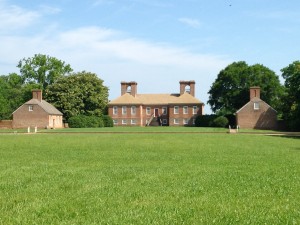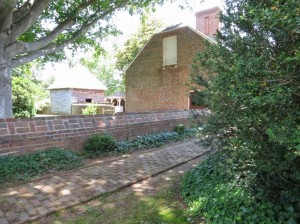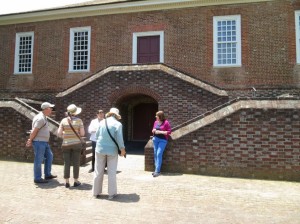One of the unexpected pleasures of writing Regency Historicals for me is researching how people lived. I’m fascinated by the mundane details of life, like what flowers grew, what food would be eaten, what furniture would be in what room. On my England tours, I asked questions everywhere about the details of carpets that were on the floors.
I tend to forget that my lovely Virginia Commonwealth has a lot of history, as well, dating back to the 1600s when Jamestown was founded. (We aren’t a state, by the way; we’re a commonwealth–according to the Hornbook of Virginia History, “A commonwealth is ‘a state in which the supreme power is vested in the people.’ The term was first given to Virginia in the 1600s)
 Last Monday, the dh and I celebrated our wedding anniversary with a trip to Westmoreland County in Virginia’s Northern Neck, the peninsula bounded by the Potomac and Rappahannock Rivers and the Chesapeake Bay. See more about our trip here.
Last Monday, the dh and I celebrated our wedding anniversary with a trip to Westmoreland County in Virginia’s Northern Neck, the peninsula bounded by the Potomac and Rappahannock Rivers and the Chesapeake Bay. See more about our trip here.
This area was filled with wealthy tobacco plantations and was the birthplace of many of our important historical figures: George Washington, James Madison, James Monroe, the two Lees who signed the Declaration of Independence, and, at Stratford Hall, the place we visited, Confederate General Robert E. Lee.
 Stratford Hall was built in 1730 by Colonel Thomas Lee who was then acting Governor of the colony. Two of his sons were the Lees who signed the Declaration of Independence. The house was built in the Georgian style, which would have been much the fashion in England at the time–very symmetrical. The main floor of the house included a Great Hall for grand entertaining, the dining room, bedchambers, parlors and the library. In the library, books were kept under lock and key; they were considered quite precious.
Stratford Hall was built in 1730 by Colonel Thomas Lee who was then acting Governor of the colony. Two of his sons were the Lees who signed the Declaration of Independence. The house was built in the Georgian style, which would have been much the fashion in England at the time–very symmetrical. The main floor of the house included a Great Hall for grand entertaining, the dining room, bedchambers, parlors and the library. In the library, books were kept under lock and key; they were considered quite precious.
 We had a fabulous guide to take us through the house and explain its features and history. (that’s me in the pink. The people in hats were, coincidentally, from England!)
We had a fabulous guide to take us through the house and explain its features and history. (that’s me in the pink. The people in hats were, coincidentally, from England!)
I saw many familiar-looking tables, chairs, bureaus, wardrobes, beds. The house was furnished much like the English country houses I’d visited on my tours.
I noticed, though, that the floors were bare. When I went on those tours of country houses in England, remember, I always asked about carpets. Almost every room had carpets of some kind. Our guide to Stratford Hall said they kept the floors bare, because the carpets would have been hard to keep clean. They might have had painted sail cloth (oil cloth) floor covering, but no carpets.
I can just imagine some wealthy gentleman from England visiting a house like Stratford Hall in the Colonies. What the Virginians would have considered quite opulent, such an English visitor must have thought very provincial. The wealthy Virginian visiting a country house in England, like Chatsworth or Burghley House, must have walked around with his mouth open.
What “great houses,” historical or otherwise, have you visited lately?
I’m still doing my Goodreads Contest!








